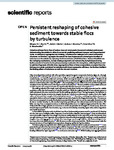Persistent reshaping of cohesive sediment towards stable flocs by turbulence
| dc.contributor.author | Yu, M | |
| dc.contributor.author | Yu, X | |
| dc.contributor.author | Mehta, AJ | |
| dc.contributor.author | Manning, Andrew | |
| dc.contributor.author | Khan, F | |
| dc.contributor.author | Balachandar, S | |
| dc.date.accessioned | 2023-02-20T12:55:17Z | |
| dc.date.issued | 2023-01-31 | |
| dc.identifier.issn | 2045-2322 | |
| dc.identifier.issn | 2045-2322 | |
| dc.identifier.other | 1760 | |
| dc.identifier.uri | http://hdl.handle.net/10026.1/20467 | |
| dc.description.abstract |
<jats:title>Abstract</jats:title><jats:p>Cohesive sediment forms flocs of various sizes and structures in the natural turbulent environment. Understanding flocculation is critical in accurately predicting sediment transport and biogeochemical cycles. In addition to aggregation and breakup, turbulence also reshapes flocs toward more stable structures. An Eulerian–Lagrangian framework has been implemented to investigate the effect of turbulence on flocculation by capturing the time-evolution of individual flocs. We have identified two floc reshaping mechanisms, namely breakage-regrowth and restructuring by hydrodynamic drag. Surface erosion is found to be the primary breakup mechanism for strong flocs, while fragile flocs tend to split into fragments of similar sizes. Aggregation of flocs of sizes comparable to or greater than the Kolmogorov scale is modulated by turbulence with lower aggregation efficiency. Our findings highlight the limiting effects of turbulence on both floc size and structure.</jats:p> | |
| dc.format.extent | 1760- | |
| dc.format.medium | Electronic | |
| dc.language | en | |
| dc.language.iso | eng | |
| dc.publisher | Springer Science and Business Media LLC | |
| dc.title | Persistent reshaping of cohesive sediment towards stable flocs by turbulence | |
| dc.type | journal-article | |
| dc.type | Journal Article | |
| plymouth.author-url | https://www.ncbi.nlm.nih.gov/pubmed/36720997 | |
| plymouth.issue | 1 | |
| plymouth.volume | 13 | |
| plymouth.publication-status | Published online | |
| plymouth.journal | Scientific Reports | |
| dc.identifier.doi | 10.1038/s41598-023-28960-y | |
| plymouth.organisational-group | /Plymouth | |
| plymouth.organisational-group | /Plymouth/Faculty of Science and Engineering | |
| plymouth.organisational-group | /Plymouth/Faculty of Science and Engineering/School of Biological and Marine Sciences | |
| plymouth.organisational-group | /Plymouth/REF 2021 Researchers by UoA | |
| plymouth.organisational-group | /Plymouth/REF 2021 Researchers by UoA/UoA07 Earth Systems and Environmental Sciences | |
| plymouth.organisational-group | /Plymouth/Research Groups | |
| plymouth.organisational-group | /Plymouth/Research Groups/Marine Institute | |
| plymouth.organisational-group | /Plymouth/Users by role | |
| plymouth.organisational-group | /Plymouth/Users by role/Academics | |
| dc.publisher.place | England | |
| dcterms.dateAccepted | 2023-01-27 | |
| dc.rights.embargodate | 2023-2-21 | |
| dc.identifier.eissn | 2045-2322 | |
| dc.rights.embargoperiod | Not known | |
| rioxxterms.versionofrecord | 10.1038/s41598-023-28960-y | |
| rioxxterms.licenseref.uri | http://www.rioxx.net/licenses/all-rights-reserved | |
| rioxxterms.licenseref.startdate | 2023-01-31 | |
| rioxxterms.type | Journal Article/Review |


